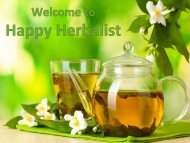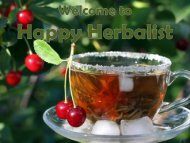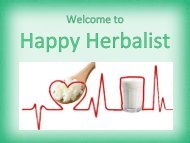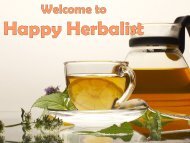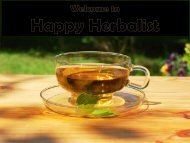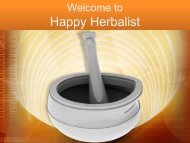Ferment Any Probiotic with Brewing Containers
You also want an ePaper? Increase the reach of your titles
YUMPU automatically turns print PDFs into web optimized ePapers that Google loves.
Welcome to<br />
Happy Herbalist
About Us<br />
Welcome to our Functional Food website. We believe food<br />
makes our life Healthy and Happy.<br />
We nurture Kombucha, Kefir, Ginger Beer, Caspian Sea<br />
Yogurt, and other <strong>Probiotic</strong> Drinks not only for their<br />
flavors but to enhance their medicinal effects.<br />
By integrating Traditional Chinese Medicine <strong>with</strong> common<br />
Teas, Herbs & Spices <strong>with</strong> these unique Functional Foods<br />
and <strong>Probiotic</strong> drinks we believe we truly can create our<br />
own little miracles.
Caspian Sea Yogurt<br />
Caspian Sea Yogurt also goes by the name Matsoni<br />
yogurt. It contains a myriad of live cultures and is one of<br />
the few yogurts that will culture at room temperature. It's<br />
also a serial culturer; meaning you can use it continually<br />
to create new cultures.<br />
It is a mesophilic culture, meaning it thrives at a moderate<br />
temperature. Culturing in winter might mean finding a<br />
warmer part of the house. It is a slightly tart yogurt <strong>with</strong> a<br />
unique viscous consistency. As it is a yogurt you create<br />
at home it is not as thick as supermarket yogurt since it is<br />
not builked out <strong>with</strong> emulsifiers.
Caspian Sea Yogurt is grown and produced by the Happy<br />
Herbalist since 1997. Different sea yogurt like:<br />
•Caspian Sea yogurt<br />
•Milk kefir<br />
•Flora probiotic<br />
•Heating mat <strong>with</strong> digital thermostat are available at here.
Heating Mats<br />
Most <strong>Probiotic</strong> <strong>Ferment</strong>s do best in a warm temperature<br />
setting. We at Happy Herbalist recommend a temperature<br />
range from 74 F to 84 F (22-28.8 C) ,for Kombucha, Jun,<br />
Ginger Beer, Water Kefir, and Vinegar. While Villi and CSY<br />
and vegetable ferments like sauerkraut do well in the mid<br />
60's (15.5 C) While one does not need constant<br />
temperature the greater the consistency the more reliable<br />
and predicable will be your ferment. OPTIONAL digital<br />
regulator helps maintain the optimal temperature <strong>with</strong>out<br />
fear of over-heating.
We at Happy Herbalist use these<br />
heaters not just for Kombucha but for<br />
our JUN, water kefir and milk kefir<br />
grains as well, depending on how cold<br />
it is. The ideal scenario would be a<br />
heater for each ferment, but if you<br />
have a lot of them, that may not be<br />
possible. Multiple small jars or a few<br />
gallon jars can each be wrapped<br />
around the heat strips we offer, so it<br />
may be possible to have a whole slew<br />
of fermented veggies going <strong>with</strong> just<br />
one or two Kombucha heating mats.
<strong>Brewing</strong> <strong>Containers</strong><br />
All our brewing containers may be used to ferment any<br />
<strong>Probiotic</strong> - Yogurt, beer, wine, cider and vinegar. Ginger<br />
Beer, Water Crystals and Kombucha can be fermented<br />
<strong>with</strong> anything that you have in your kitchen. It really does<br />
not matter to the Kombucha SCOBY. It is, a matter of<br />
preference.
For the connoisseur of kombucha. Aluminum,<br />
and of Couse lead vessels should be avoided<br />
for one's own personal health.<br />
What matters most to the kombucha and vinegar<br />
production is the shape of the container. The larger<br />
the surface area the better. The depth does not matter. The<br />
ratio of surface to depth does not matter. What is<br />
important is that the Acetobacter bacteria have as much<br />
surface oxygen as possible. Adequate ventilation is<br />
required. Lactobacillus and yeast ferment <strong>with</strong> or <strong>with</strong>out<br />
oxygen.
All ferments give off heat, evaporation and odor.<br />
Therefore be sure not to enclose your container in too<br />
tight a space, and to leave sufficient headroom (typically 3<br />
-4 inches) from the top of the container to anything above<br />
the container such as a shelf. Evaporation may condense<br />
on the surface just above and condense back into the<br />
ferment causing contamination. Evaporation may also<br />
condense in corners and <strong>with</strong>out light, mold and mildew<br />
rapidly develops. Contrary to popular belief normal room<br />
light will not adversely affect the ferment.
Contact Us<br />
516 Alliance Circle Cary,<br />
North Carolina 27519,<br />
USA<br />
Phone Number: 919-518-3336<br />
Toll Free: 888-425-8827
Thank You<br />
&<br />
Visit Again<br />
https://www.happyherbalist.com/





